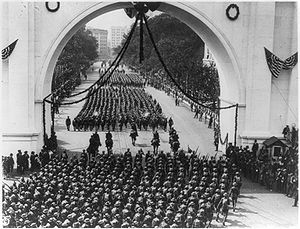Depression of 1920-21
|
A 1919 parade in Minneapolis for soldiers returning home after World War I. The upheaval associated with the transition from a wartime to peacetime economy contributed to a depression in 1920 and 1921.
|
| Economic data for 1920–21 recession | |||
|---|---|---|---|
| Estimate | Production | Prices | Ratio |
| 1920–21 (Commerce) | −6.9% | −18% | 2.6 |
| 1920–21 (Balke & Gordon) | −3.5% | −13% | 3.7 |
| 1920–21 (Romer) | −2.4% | −14.8% | 6.3 |
| 1929–30 | −8.6% | −2.5% | 0.3 |
| 1930–31 | −6.5% | −8.8% | 1.4 |
| 1931–32 | −13.1% | −10.3% | 0.8 |
| Unemployment rate | ||
|---|---|---|
| Year | Lebergott | Romer |
| 1919 | 1.4% | 3.0% |
| 1920 | 5.2% | 5.2% |
| 1921 | 11.7% | 8.7% |
| 1922 | 6.7 | 6.9% |
| 1923 | 2.4 | 4.8% |
The Depression of 1920–21 was a sharp deflationary recession in the United States and other countries, 14 months after the end of World War I. It lasted from January 1920 to July 1921. The extent of the deflation was not only large, but large relative to the accompanying decline in real product.
There was a brief post–World War I recession immediately following the end of the war which lasted for 2 years, complicating the absorption of millions of veterans into the economy. The economy started to grow, though it had not yet completed all the adjustments in shifting from a wartime to a peacetime economy. Factors identified as contributing to the downturn include: returning troops which created a surge in the civilian labor force and problems in absorbing the veterans, a decline in labor union strife, changes in fiscal and monetary policy, and changes in price expectations.
Following the end of the depression, the Roaring Twenties brought a period of economic prosperity in the US.
The recession lasted from January 1920 to July 1921, or 18 months, according to the National Bureau of Economic Research. This was longer than most post–World War I recessions, but was shorter than recessions of 1910–12 and 1913–1914 (24 and 23 months respectively). It was significantly shorter than the Great Depression (132 months). Estimates for the decline in Gross National Product also vary. The U.S. Department of Commerce estimates GNP declined 6.9%, Nathan Balke and Robert J. Gordon estimate a decline of 3.5%, and Christina Romer estimates a decline of 2.4%. There is no formal definition of economic depression, but two informal rules are a 10% decline in GDP or a recession lasting more than three years, and the unemployment rate climbing above 10%.
The recession of 1920–21 was characterized by extreme deflation—the largest one-year percentage decline in around 140 years of data. The Department of Commerce estimates 18% deflation, Balke and Gordon estimate 13% deflation, and Romer estimates 14.8% deflation. The drop in wholesale prices was even more severe, falling by 36.8%, the most severe drop since the American Revolutionary War. This is worse than any year during the Great Depression (adding all the years of the Great Depression together, however, yields more severe deflation). The deflation of 1920–21 was extreme in absolute terms, and also unusually extreme given the relatively small decline in gross domestic product.
...
Wikipedia

